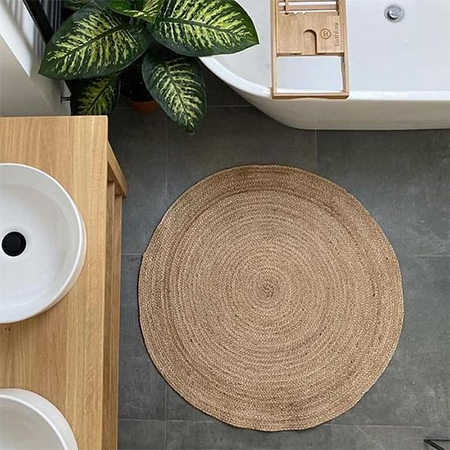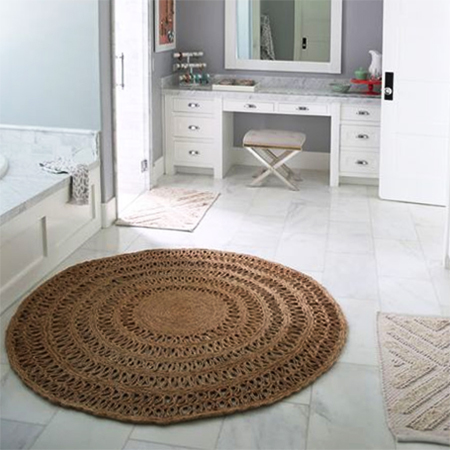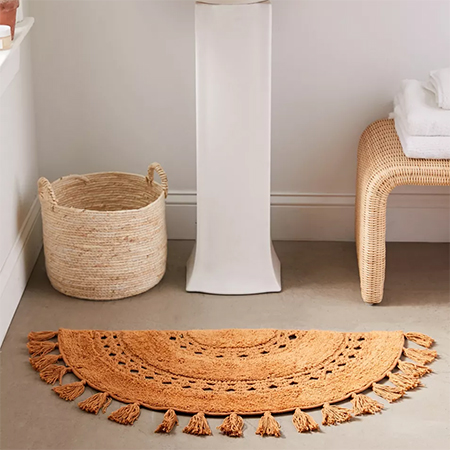How Clean are the Mats in your Bathroom?
It might seem like a strange topic to cover, but in many homes, bathmats are not cleaned as often as they should be.
30/09/2021
It's not something you think about every laundry day, but when was the last time your bathmats were cleaned? Just like the towels you use in the bathroom, bathmats get just as much use, but we tend to overlook this. Whether you have a mat outside the shower cubicle or bathtub, or mats in front of a vanity or basin, or even a mat in front of the toilet, bathrooms harbour the most germs and bacteria. Not something you want to think about.
Because bathmats are subjected to daily use, it is recommended that they be cleaned weekly or as and when you clean your bath and hand towels. But cleaning bathmats isn't just about throwing them in the washing machine because, for certain bathmats, this might destroy them. We look at some different options for cleaning bathmats depending on the type you have in your bathroom.
Bathmats can be purchased in all shapes and sizes and different materials. There are woven textile bath mats, organic (coir, jute or sisal) bathmats, bamboo bathmats and even luxurious fluffy bathmats. Most of these would most certainly be destroyed if placed in the washing machine.
If you want your bathmats to last, rather give them a hand wash rather than popping them in a washing machine.
Hand Wash Bathmats
With the exception of organic bath mats woven using coir, sisal, bamboo and similar, it is safer to wash bathmats by hand. This is particularly important if you have memory foam, fibre-filled or fluffy bathmats. You don't want to damage any filling or spoil the fluffiness. Washing by hand is far less extreme than a washing machine but will still leave bathmats clean and refreshed.
YOU WILL NEED:
Soft bristle brush
White spirit vinegar
Cold water washing detergent
Galvanised or plastic tub
HERE'S HOW:
Step 1
Shake the bathmat outdoors to remove any loose dirt. I like to give it a good beating with my hand to loosen as much dirt as possible that has become ingrained deep in the fibres. Remove any remaining trapped dirt by brushing with a soft brush.
Step 2
To disinfect the bathmat there's nothing that works as well as a 1:1 solution of water and white spirit vinegar. Combine these in a spray bottle that you can spray onto the bathmat. It also works well for any stained areas on the mats. Leave on for a couple of minutes to let the mixture soak deep into the fibres.
Step 3
Fill a bathtub, galvanised or plastic tub with cold water and washing detergent, and place the bathmat in to soak before rinsing with clean water.
Step 4
There is nothing like sunshine to kill off bacteria and any remaining germs. Place the bathmat on a flat surface where it can dry and flip over occasionally to allow it to dry thoroughly.
Step 5
If you need to remove stains, use a dry carpet cleaner to gently brush and spot the stains with a cloth..
Coir, sisal and jute mats are suitable only for those bathrooms that are well-ventilated, as moist conditions can result in mould and rot.
pinterest.com/pin/536561743107548390/
Clean Coir, Sisal or Seagrass Bathmats
Any organic material shouldn't be left wet for long as it will attract mould and the fibres will break. I know that some people do wash their organic mats, but it is far better to use a dry-cleaning method if you want organic mats to last longer. If you are looking to purchase organic mats for your home, and particularly a bathroom or kitchen, buy ones that don't have a latex backing. Organic materials need to breathe and having a latex backing on a mat in a bathroom may well result in mould.
YOU WILL NEED:
Soft bristle brush
Bicarbonate of Soda (baking powder)
pinterest.com/pin/4996249576778070/
HERE'S HOW:
Step 1
Take organic mats outdoors and give them a good shake to remove any loose dirt. Lightly brush with a soft brush to get into gaps around the fibres and remove any ingrained dirt.
Step 2
To refresh organic mats, sprinkle the mats with Bicarbonate of Soda (baking powder). Use a soft brush to ensure the Bicarb is worked well into the fibres and then leave overnight. In the morning, give the mat another good shake and use the soft brush to remove any remaining powder and then vacuum clean.
Clean Plastic or Vinyl Bathmats
Plastic or vinyl bathmats either in a shower or bathtub or on floors, need to be cleaned regularly to disinfect them and remove any traces of mould. The easiest way to clean these bathmats is with a scrubbing brush and mixture of 1:1 water and white spirit vinegar or, if you prefer, use household bleach.







